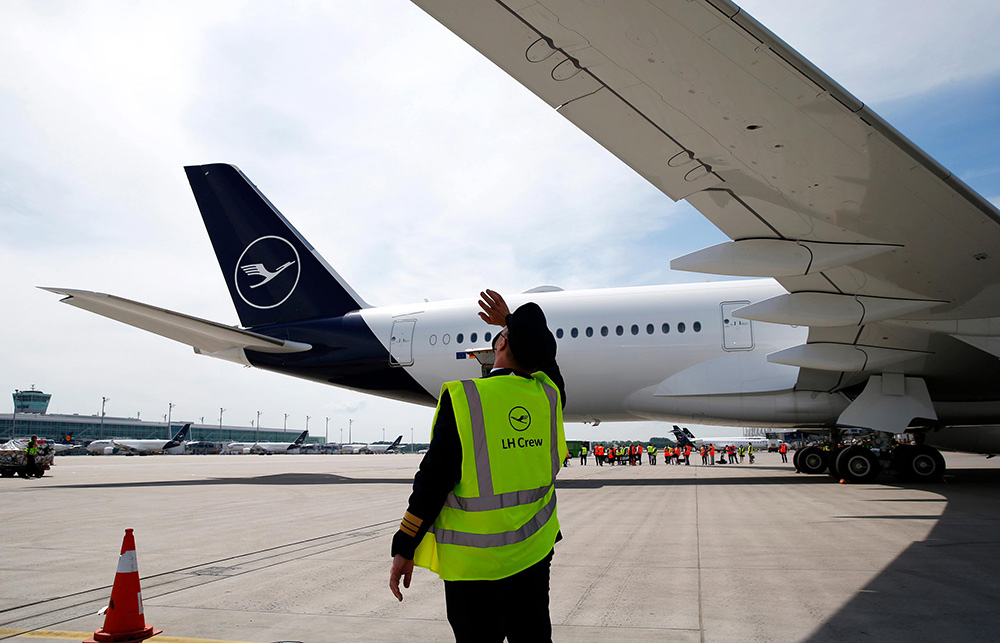
拥有奥地利、瑞士和比利时主要航空公司的德国汉莎航空集团近期宣布裁员不超过2.2万人。
《财富》杂志估算,这条新闻将让全球各主要航空公司披露的裁员总人数达到7万人左右,而且必然还会出现更多裁员消息。再加上波音等供应商即将开始的裁员行动,目前看来,新冠疫情将使航空业失去逾10万个就业机会。但要指出一点,那就是按照和美国联邦政府签订的新冠疫情薪资支持计划协议,已经宣布裁员的美国航空公司不能在9月底前采取行动。
在宣布裁员的几周前,汉莎航空集团接受了德国政府98亿美元的援助,德国政府将借此获得该集团20%的股份。此项计划还需获得汉莎股东以及欧盟委员会的批准。奥地利政府也向汉莎融资5.10亿美元,瑞士政府则提供了13.5亿美元的贷款担保。
汉莎首席执行官卡斯滕•斯波尔在上周表示,可能需要通过“广泛的重组”和出售资产来偿还德国政府的援助资金。
上述裁员行动就是该集团的第一波行动。
汉莎的人力资源负责人迈克尔•尼格曼在一份声明中称:“如果不在本次危机中大幅降低人力成本,我们就会失去更好地从这场危机中重启的机会,而且有可能在危机过后使汉莎的实力显著下降。此外,人员不确定性可能变的比以往任何时候都大,因此或许不可避免地需要通过单边措施来降低这种不确定性。我们希望能避免这样的情况。”
两个月前,拥有超过763架飞机的汉莎曾经表示可能将旗下飞机数量削减十分之一左右。现在该集团预计本次危机过后其机队规模将缩小100架左右。甚至是在新冠疫情爆发前,这家老牌航空公司就已经打算通过整合业务来保持竞争力。该集团于今年4月表示,疫情对航空业的极端影响只是“加快了”这些计划的实施步伐。
汉莎航空集团的员工数量超过13.5万人,其中一半在德国。而德国也占本次裁员计划的一半,其中许多都来自该集团的行政部门以及第三方服务业务。
汉莎即将开始的裁员(目前仍在和工会协商)是本次航空业危机爆发以来规模最大的裁员计划。另外,许多航空公司都已经被迫或借机压缩人员数量,而且几乎所有业内人士都认为航空业需要几年时间来复苏。
以下我们列出了过去几个月内航空公司披露的主要裁员计划,其中不包括波音(近1.3万人)和空客(据报道不超过1万人)等供应商以及航空发动机制造商罗尔斯•罗伊斯(9000人),也不包括许多较小的航空公司。仅在英国,研究人员就预测如果英国政府不向从业人员提供更多帮助,航空业将损失12.4万个就业机会。
英国航空公司
今年4月底,英国航空表示最多将裁员1.2万人。作为国际航空集团(IAG)的子公司,英航有大约4.2万名员工,因此裁员比例要高于汉莎,只是员工总数少于后者。
阿联酋航空集团
阿联酋航空的裁员人数可能居行业首位,原因是彭博社报道称该集团的裁员规模可能达到3万人。作为迪拜旗舰航空公司,阿联酋航空在全球雇佣了10.5万人左右,而且员工总数一直不甚明了。到目前为止,新闻报道称该公司已经有逾7200名空乘人员、飞行员和技师下岗。
美国航空公司
美国航空的员工人数几乎达到12.9万。该公司在5月底表示将裁掉约30%的管理和支持性服务人员。按此计算,美航将削减约5000个岗位。只是受航空公司和美国联邦政府签订的援助协议约束,9月底前美航不能裁员。
北欧航空公司
北欧航空是丹麦、挪威和瑞典联合组建的旗舰航空公司。今年4月底,该公司表示可能裁员不超过5000人,几乎占员工总数的一半。
挪威航空公司
作为北欧航空的对手,挪威航空的瑞典和丹麦子公司于今年4月底申请破产。挪威航空还终止了美国和欧洲的一系列雇佣合同。该公司可能削减的岗位共有4700个。
易捷航空
英国平价航空公司易捷航空将裁员约4500人,占员工总数的30%。该公司还警告,如果英国政府继续要求入境人员隔离两周,它甚至有可能继续裁员。
联合航空公司
今年5月初,基于内部备忘录的新闻报道显示,联合航空计划将管理和行政人员削减30%,意味着约3500人将下岗。不过,新任CEO斯科特•科尔比随后表示,如果可能他希望不裁员。
维珍航空公司
维珍航空在5月初表示将裁员3150人,这样该公司就有望“在2021年重新盈利”。
瑞安航空公司
今年5月初,易捷航空的竞争对手瑞安航空(同样明确反对英国政府的入境人员隔离政策)表示将裁员3000人,占员工总数的15%。
阿拉斯加航空公司
阿拉斯加航空拥有约2.3万名员工。该公司在上周三表示将裁员3000人。
维珍航空(澳洲)
维珍航空(澳洲)于4月底申请破产。与收购投标人见面后,该公司工会担心可能会有多达2000人下岗。(财富中文网)
译者:Biz
拥有奥地利、瑞士和比利时主要航空公司的德国汉莎航空集团近期宣布裁员不超过2.2万人。
《财富》杂志估算,这条新闻将让全球各主要航空公司披露的裁员总人数达到7万人左右,而且必然还会出现更多裁员消息。再加上波音等供应商即将开始的裁员行动,目前看来,新冠疫情将使航空业失去逾10万个就业机会。但要指出一点,那就是按照和美国联邦政府签订的新冠疫情薪资支持计划协议,已经宣布裁员的美国航空公司不能在9月底前采取行动。
在宣布裁员的几周前,汉莎航空集团接受了德国政府98亿美元的援助,德国政府将借此获得该集团20%的股份。此项计划还需获得汉莎股东以及欧盟委员会的批准。奥地利政府也向汉莎融资5.10亿美元,瑞士政府则提供了13.5亿美元的贷款担保。
汉莎首席执行官卡斯滕•斯波尔在上周表示,可能需要通过“广泛的重组”和出售资产来偿还德国政府的援助资金。
上述裁员行动就是该集团的第一波行动。
汉莎的人力资源负责人迈克尔•尼格曼在一份声明中称:“如果不在本次危机中大幅降低人力成本,我们就会失去更好地从这场危机中重启的机会,而且有可能在危机过后使汉莎的实力显著下降。此外,人员不确定性可能变的比以往任何时候都大,因此或许不可避免地需要通过单边措施来降低这种不确定性。我们希望能避免这样的情况。”
两个月前,拥有超过763架飞机的汉莎曾经表示可能将旗下飞机数量削减十分之一左右。现在该集团预计本次危机过后其机队规模将缩小100架左右。甚至是在新冠疫情爆发前,这家老牌航空公司就已经打算通过整合业务来保持竞争力。该集团于今年4月表示,疫情对航空业的极端影响只是“加快了”这些计划的实施步伐。
汉莎航空集团的员工数量超过13.5万人,其中一半在德国。而德国也占本次裁员计划的一半,其中许多都来自该集团的行政部门以及第三方服务业务。
汉莎即将开始的裁员(目前仍在和工会协商)是本次航空业危机爆发以来规模最大的裁员计划。另外,许多航空公司都已经被迫或借机压缩人员数量,而且几乎所有业内人士都认为航空业需要几年时间来复苏。
以下我们列出了过去几个月内航空公司披露的主要裁员计划,其中不包括波音(近1.3万人)和空客(据报道不超过1万人)等供应商以及航空发动机制造商罗尔斯•罗伊斯(9000人),也不包括许多较小的航空公司。仅在英国,研究人员就预测如果英国政府不向从业人员提供更多帮助,航空业将损失12.4万个就业机会。
英国航空公司
今年4月底,英国航空表示最多将裁员1.2万人。作为国际航空集团(IAG)的子公司,英航有大约4.2万名员工,因此裁员比例要高于汉莎,只是员工总数少于后者。
阿联酋航空集团
阿联酋航空的裁员人数可能居行业首位,原因是彭博社报道称该集团的裁员规模可能达到3万人。作为迪拜旗舰航空公司,阿联酋航空在全球雇佣了10.5万人左右,而且员工总数一直不甚明了。到目前为止,新闻报道称该公司已经有逾7200名空乘人员、飞行员和技师下岗。
美国航空公司
美国航空的员工人数几乎达到12.9万。该公司在5月底表示将裁掉约30%的管理和支持性服务人员。按此计算,美航将削减约5000个岗位。只是受航空公司和美国联邦政府签订的援助协议约束,9月底前美航不能裁员。
北欧航空公司
北欧航空是丹麦、挪威和瑞典联合组建的旗舰航空公司。今年4月底,该公司表示可能裁员不超过5000人,几乎占员工总数的一半。
挪威航空公司
作为北欧航空的对手,挪威航空的瑞典和丹麦子公司于今年4月底申请破产。挪威航空还终止了美国和欧洲的一系列雇佣合同。该公司可能削减的岗位共有4700个。
易捷航空
英国平价航空公司易捷航空将裁员约4500人,占员工总数的30%。该公司还警告,如果英国政府继续要求入境人员隔离两周,它甚至有可能继续裁员。
联合航空公司
今年5月初,基于内部备忘录的新闻报道显示,联合航空计划将管理和行政人员削减30%,意味着约3500人将下岗。不过,新任CEO斯科特•科尔比随后表示,如果可能他希望不裁员。
维珍航空公司
维珍航空在5月初表示将裁员3150人,这样该公司就有望“在2021年重新盈利”。
瑞安航空公司
今年5月初,易捷航空的竞争对手瑞安航空(同样明确反对英国政府的入境人员隔离政策)表示将裁员3000人,占员工总数的15%。
阿拉斯加航空公司
阿拉斯加航空拥有约2.3万名员工。该公司在上周三表示将裁员3000人。
维珍航空(澳洲)
维珍航空(澳洲)于4月底申请破产。与收购投标人见面后,该公司工会担心可能会有多达2000人下岗。(财富中文网)
译者:Biz
Germany's Lufthansa Group—which also owns major airlines in Austria, Switzerland, and Belgium—has announced up to 22,000 job cuts.
By Fortune’s calculation, the news takes the total number of announced major-airline job cuts up to around 70,000—and more will surely come. Taking into account looming cuts at suppliers such as Boeing, the coronavirus pandemic now seems set to claim many more than 100,000 jobs in the sector. One caveat: For the U.S. carriers on this list, the cuts cannot take place before the end of September, due to the terms of the airlines' federal coronavirus payroll support deals.
Lufthansa's move comes weeks after the group agreed to a $9.8 billion bailout with the German government that will see the government take a 20% stake in the company—shareholders and the European Commission still need to sign off on this. The Austrian government has also given the carrier group $510 million, and the Swiss government has given it $1.35 billion in loan guarantees.
Lufthansa CEO Carsten Spohr said last week that "far-reaching restructuring measures" and asset sales would be needed to repay the German bailout.
And the first wave is here.
"Without a significant reduction in personnel costs during the crisis, we will miss the opportunity of a better restart from the crisis and risk that the Lufthansa Group will emerge considerably weakened after it," said Lufthansa human resources chief Michael Niggemann in a statement. "In addition, personnel overhang is likely to become even larger, so that a reduction of personnel overhang by implementing unilateral measures would be inevitable. We want to avoid this scenario."
It is two months since Lufthansa said it would be cutting the size of its 763-strong fleet by around a tenth—it now expects the fleet to come out of the crisis having shrunk by around 100 planes. Even before the pandemic, the legacy carrier group was looking to consolidate its operations to stay competitive; COVID-19's extreme impact on the sector just "accelerated" those plans, the company claimed in April.
Lufthansa Group employs over 135,000 people, half in Germany—where half the cuts will take place, many in administration and the group's third-party services business.
Lufthansa's looming headcount reduction (which is still the subject of negotiations with unions) is the largest announced so far in the current aviation crisis. But many carriers are being forced, or taking the opportunity, to downsize—and pretty much everyone expects the sector to take several years to recover.
Here's a quick rundown of the most significant announcements of cuts made by carriers in the past couple of months. Not included are cuts at their suppliers, such as Boeing (nearly 13,000 jobs), Airbus (reportedly up to 10,000) and engine-maker Rolls-Royce (9,000), not to mention a host of smaller firms. In the U.K. alone, researchers are forecasting the loss of 124,000 jobs in the sector unless the British government extends additional help to aviation industry workers.
British Airways
BA said at the end of April that it would cut up to 12,000 jobs—as the IAG subsidiary employs around 42,000 people, that's a higher proportion than Lufthansa is planning to shed, albeit a smaller overall number.
Emirates Group
The Emirates Group might end up with the heftiest cuts of all, as Bloomberg has reported a likely reduction in the order of 30,000. However, the Dubai flag carrier, which employs around 105,000 people around the world, has been vague about totals. So far, Emirates has reportedly laid off more than 7,200 cabin crew, pilots, and engineers.
American Airlines
American, which has almost 129,000 employees, said late May that it would be cutting roughly 30% of its management and support services. That means roughly 5,000 jobs will go, though the cuts cannot take place before the end of September because of the airlines' federal bailout stipulations.
SAS
Scandinavian Airlines, the joint flag carrier for Denmark, Norway, and Sweden, said late April that it could cut up to 5,000 jobs, or almost half its workforce.
Norwegian Air
SAS rival Norwegian saw four of its Swedish and Danish subsidiaries file for bankruptcy in late April. It also ended a range of staffing contracts in the U.S. and Europe. Altogether, 4,700 jobs are at risk.
EasyJet
The British low-cost airline EasyJet is cutting around 4,500 jobs, or 30% of its workforce—and it’s warning of even more if the British government maintains two-week-quarantine requirement for people arriving in the U.K.
United Airlines
A report in early May, based on an internal memo, suggested United was planning to lay off 30% of its managerial and administrative workforce—that would mean around 3,500 lost jobs. However, new CEO Scott Kirby subsequently said he wants to avoid the measure if possible.
Virgin Atlantic
Virgin Atlantic said in early May that 3,150 jobs would be cut, so the airline could "return to profitability in 2021."
Ryanair
EasyJet competitor Ryanair (also a vocal opponent of the U.K.'s quarantine requirements) said at the start of May that it would shed around 3,000 jobs, or 15% of its workforce.
Alaska Airlines
Alaska Airlines, which employs around 23,000 people, said last Wednesday that it will shed up to 3,000 jobs.
Virgin Australia
Virgin Australia filed for bankruptcy protection in late April. Having met with bidders, unions now fear as many as 2,000 jobs could be cut.






